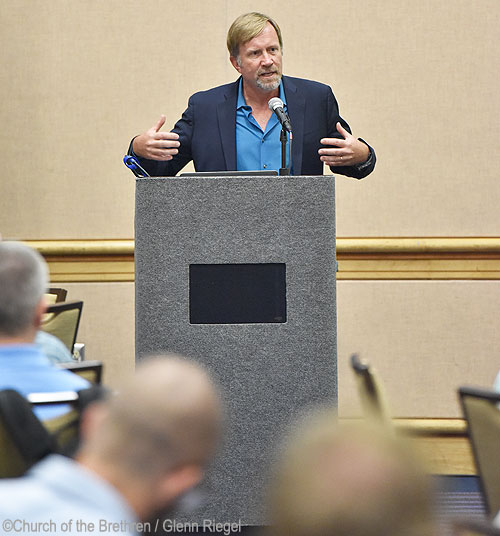
Jonathan Reed speaks at the General Secretary’s Luncheon with Higher Education
By Karen Garrett
University of La Verne, Calif., was the institution highlighted this year at the General Secretary’s Luncheon with Higher Education. Keynote speaker Dr. Jonathan Reed addressed the luncheon on the topic of “Who Was Jesus?”
To answer that question, Reed led the group through an archeological adventure. He believes that by correctly understanding the situation of the early church, we will get the theology for the 21st century correct.
He gave a quick lesson on the history of archeology. Early archeology focused on finding sites mentioned in the Bible, for example a particular city. Later archeologists excavated these sites asking the question, “Is this the actual place mentioned in scripture?” with one goal being to prove the Bible to be true.
When researching New Testament sites, the purpose is not to prove Jesus to be true but rather to understand the context when Jesus lived, according to Reed. Through numerous slides, graphs, charts, and photos, Reed focused on ethnicity, socioeconomic, religious, and political data about the New Testament world.
Most intriguing was his pointing to data around death rates, causes of death, and demographics to understand the era when Jesus lived. Why did Jesus so often speak of orphans and widows? There is data that by the time most people were age 30 (Jesus’ age when he began his ministry) it was very unlikely that their grandfather was living, and rare that their father was still living. This resulted in many widows and orphans.
Archeology data points to one main reason for the death rate being malaria. Due to high infant mortality and early childhood death rates, families often had many children. At the time of Jesus, the population of the area around Nazareth doubled in 10 years. Communities that first located on the tops of hills needed to move to valleys and cities simply to have space to live, however that is where mosquitoes live, and malaria spread.
Mark 1:30 tells of Peter’s mother-in-law in bed with a fever. Could the fever have been malaria? Reed’s presentation left us with a deeper appreciation for such details in scripture as “in bed with a fever.”
General secretary Stan Noffsinger initiated this luncheon at the 2014 Annual Conference. He saw value in members from the higher education community gathering in this type of venue as a way to remain in conversation with one another. Noffsinger stated that he trusts the luncheon can continue after he leaves the office of General Secretary.
— Karen Garrett is a member of the volunteer news team for Annual Conference. She is manager of “Brethren Life and Thought” and is on the staff of Bethany Theological Seminary.